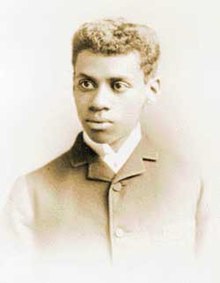William Hallett Greene
William Hallett Green | |
|---|---|
 | |
| Born | c. October 1864 New York City, New York |
| Died | May 1942 (aged 77–78) |
| Allegiance | |
| Service | |
| Unit | Signal Corps |
| Alma mater | City College of New York |
William Hallett Greene or Green (c. October 1864 – May 1942) was the first black member of the U.S. Signal Corps, the first black graduate of City College of New York,[1] and first black meteorologist.
Family and education
Greene was born in New York City as the son of Susan Bulkley and Hallett Green, recorded in the census as a mulatto coachman who owned his residence on W. 31st Street.[1][2] William graduated from City College (now part of the City University of New York) at the age of 19 with a Bachelor of Science degree in 1884. The New York Times reported on his class' graduation, noting that "W.H. Greene is the first colored boy who has ever graduated from the college, and he has made a good record. The audience applauded him liberally last night."[3] His portrait now hangs in the Trustee Lounge of the City University of New York.[1]
Enlistment in the Signal Corps
Greene applied to the U.S. Signal Corps but was initially rejected, as they did not accept any black members at that time. His case was taken up by the then-president of City College, General Alexander Webb, who wrote to Secretary of War Robert Todd Lincoln on behalf of Greene. Lincoln agreed that Greene deserved a place in the Signal Corps but faced strong opposition from Brigadier General William Hazen, Commanding Officer of the Signal Corps. Hazen's opposition rested on the convention (approved by Congress) that black soldiers could only serve in four regiments, two in the cavalry and two in the infantry.[4] After Lincoln overruled Hazen's interpretation of this convention, Greene was accepted into the U.S. Signal Corps as its first African-American member. He had received a high score on the Corps' competitive entrance exam.[5]
Greene served under conditions of duress in Pensacola, Florida, before being transferred to Rochester, New York. In 1887, only a few years after he enlisted, Greene was unfairly yet dishonorably discharged from the Corps after a series of disputed claims regarding his behavior and character. He later changed his name and moved to New Orleans, Louisiana to start a new life with a new identity to escape the pain and dishonor brought to him at the hands of the military during Jim Crow.[1]
Legacy
His enlistment in the Signal Corps in September 1884 opened the door for other African-Americans to enlist in some branches of the Army from which they were previously barred, including the Hospital Corps, Ordnance Corps, Commissary, and Quartermaster Departments.[4][6]
Greene is considered to be the first black meteorologist and first black station chief in the Signal Corps.[7]
In 2007, the New York State Assembly's Standing Committee on Veterans’ Affairs paid tribute to Greene's triumphs and challenges with a resolution, "Honoring the Life and Accomplishment of William Hallett Greene, the First Black Graduate of the City University of New York, and Member of the United States Army Signal Corps."[8]
See also
References
- ^ a b c d "William H. Greene was the First Black CUNY Graduate and First Black Member of U.S. Signal Corps, a Victor and a Victim". CUNY Newswire. Retrieved 2018-04-30.
- ^ Hallett Green family in the 1870 and 1880 census
- ^ "The City College Annual Commencement in the Academy of Music". The New York Times. 1884-06-27. ISSN 0362-4331. Retrieved 2018-04-30.
- ^ a b Foner, Jack (1970). The United States soldier between two wars: Army life and reforms, 1865-1898. New York: Humanities Press. p. 141. ISBN 0391000063. OCLC 97050.
- ^ Adams, Kevin (2009). Class and race in the frontier Army: Military life in the West, 1870-1890. Norman: University of Oklahoma Press. p. 165. ISBN 978-0806185132. OCLC 821216804.
- ^ Smith, Steven D.; Zeidler, James A. (1998). A Historic Context for the African-American Military Experience (PDF). U.S. Army Corps of Engineers. p. 113. Archived (PDF) from the original on February 26, 2017.
- ^ Conner, Glen (2016). "A Footnote to Florida's Observational History". Slide Player via Florida State University, Center for Ocean-Atmospheric Prediction Studies. Retrieved 2018-07-31.
- ^ "Annual Report of the New York State Assembly Standing Committee on Veterans' Affairs" (PDF). nyassembly.gov. 2007. Archived from the original (PDF) on 2018-04-30.
